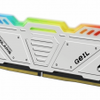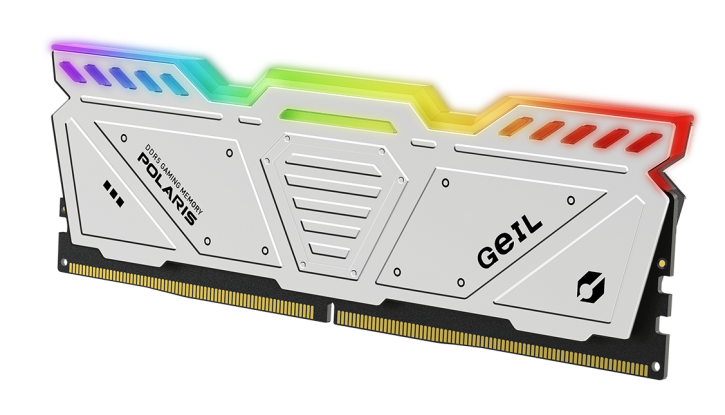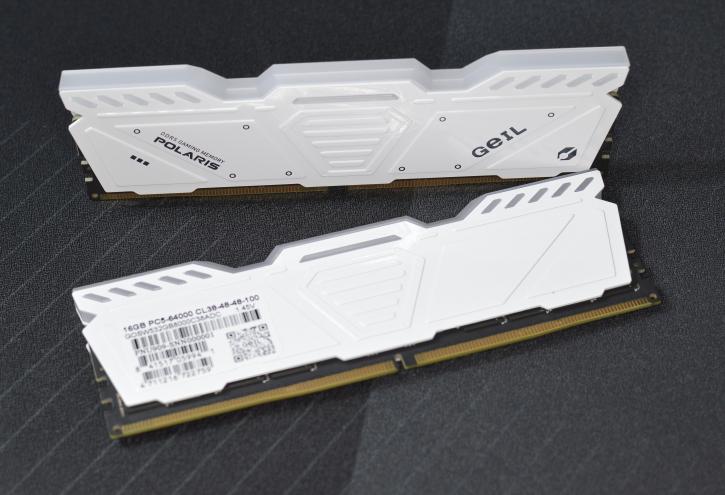Introduction
Geil Polaris RGB 8000 CL38 DDR5
8000 MHz CL38 32 GB (2x 16 GB)
Geil (Golden Emperor International Limited) is headquartered in Taipei, Taiwan. It was founded in 1993 and will have its 30th anniversary this year. At the end of last year, we had an opportunity to check their Evo V DDR5 memory kit (that earned the "Approved" award), consisting of two 16 GB modules with a frequency of 6200 MHz and CL34 latency. What are the main differences vs. Evo V? Mainly, the design of a radiator and the lack of two fans used for active cooling of the modules. This time, we will review Geil’s second series, Polaris RGB (there’s also a “regular” Polaris without the lighting), with an astonishing frequency of 8000 MHz.
A quick reminder - DDR5 is the newest technology to hit the market, make headlines, and break world records. DDR5 already set spectacular results in overclocking (of course, using the LN2), as even 10550 MHz. DDR4 RAMs operate on a single 64-bit bus, while DDR5 has two 32-bit buses (plus, in both cases, an additional 8-bit for ECC). As a result, a single module is identified as Dual Channel, while two are identified as Quad Channel. However, the solution does not match the throughput of HEDT platforms with processors with a four-channel controller. The internal (A / B) channels of DDR5 RAM also share the RCD (Register Clock Driver), which provides more output signals and more extended pulse reading (8 vs. 16). The DDR5 comes with a Power Management Integrated Circuit (PMIC) from the most important things you need to know. It’s responsible for controlling voltage changes, optimizing the energy draw, and making it less demanding for the motherboard controller. The DDR4 nominal voltage is 1.2 V; for the DDR5, it’s 1.1 V. Typical XMP voltage for the older type of memory is 1.35V (sometimes 1.45 V); now, it’s mostly 1.25 V. Speaking of the XMP, till now, it was 2.0 revision, with the introduction of the DDR5 we’ve got the rev 3.0. The main difference is that the number of profiles has increased from three to five (three for the manufacturer settings and two placeholders for the users). After this short introduction – let’s present a bit of the review sample. There are three color variants:
- Titanium Gray
- Racing Red
- Glacier White (which we got)
Our sample is the highest frequency kit from the Geil Polaris RGB series, with an 8000 MHz clock, CL38-48-48-100, at 1.45V. As for the capacities of this family, you can find the following:
- Single Pack: 8GB, 16GB, 32GB
- Dual Channel Kit: 16GB (8GB*2), 32GB (16GB*2), 64GB (32GB*2)
As for the frequencies, there are the following variants available:
- 4800 MHz
- 5200 MHz
- 5600 MHz
- 6000 MHz
- 6200 MHz
- 6400 MHz
- 6600 MHz
- 6800 MHz
- 7200 MHz
- 7600 MHz
- 8000 MHz (which we’re checking)
There’s also a Polaris without the RGB lighting on offer (with the frequencies) up to 6600 MHz. Overall, this Geil memory kit seems like a fantastic option for those looking for high-enough-performance memory with nice RGB lighting.
The RGB can be controlled via the following:
- Asus Aura Sync
- Asrock Polychrome RGB
- Gigabyte RGB Fusion 2.0
- MSI Mystic Light Sync
It’s a series with an XMP profile, no AMD EXPO to be found here (there’s a separate version for that). The height of the memory module is 43 mm/1.69 inches, so it’s a relatively low-profile form, which should cause rare problems with the (air) CPU coolers. As for (official) compatibility – there are only Intel chipsets (and for the higher frequency kits – the Z790 chipset is advised for 6800+ MHz).
The series is equipped with RGB, so the LED enjoyers should be happy (as we mentioned earlier, there’s a variant without the lighting). We’ll check the kit on two platforms, with Z790-based motherboards (Asus Z790 Maximus Hero and Z790 Maximus Apex ) combined with the Intel Core i9 13900K and the Asrock X670E Steel Legend combined with an AMD Ryzen 9 7900X. This time, the used GPU is the Nvidia Geforce RTX 4090, so it shouldn’t be a limiting factor for the memory performance. We are traditionally going to try and squeeze something more out of it, although the standard 8000 MHz is already very demanding for the hardware.
You’d better have an Intel CPU with a good IMC (Integrated Memory Controller) and a 2 DIMM motherboard (like the Z790 Apex that Geil provided). Another thing worth mentioning is that you’d better keep the memory cooler than 70 degrees Celsius, but it’s even more preferred to stay below 60 degrees.
The default parameters and visual aspects look superb – we must check the performance then. A limited lifetime warranty backs the Geil Polaris RGB series. Ok, next page, please.



